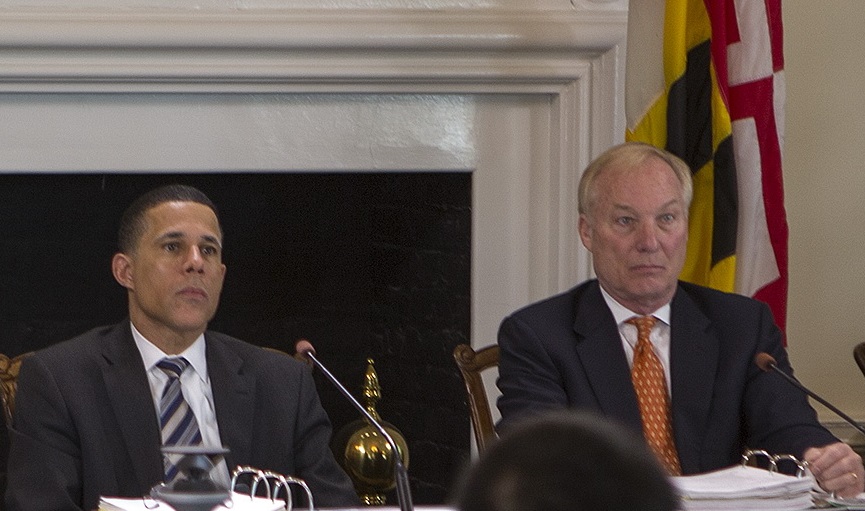By Glynis Kazanjian
Local election officials are already expressing uncertainty about what could go wrong when the state switches from an electronic voting system to using paper ballots in the next two years.
By the 2016 presidential elections the state will replace touch-screen machines and make a fundamental shift to the way voters cast ballots.
“This is a big transition for us,” said Montgomery County Board of Elections Deputy Director Alysoun McLaughlin. “Everything from set up, to warehouses, to the voting experience is based around touch screen [voting] machines.”
McLaughlin attended a demonstration last week in Baltimore where Dominion Voting Systems showcased a paper ballot scanning unit to local elections officials that the state will consider purchasing for use in 2016.
Long lines a possible concern
State officials are considering using an average of one or two optical scan machines per precinct. Dominion estimates it will take a voter five seconds to feed their ballot into the machine, but election officials foresee various reasons for it taking longer, including delays when ballots are incorrectly marked.
“It’s giving inconsistent results,” said Ben Frey of Wicomico County, a state election official who tests election systems. Frey deliberately marked ballots incorrectly and then fed them into the Dominion scanner, but the message results were different each time he said.
Another election official asked what happens if the scanner jams.
“I’m not saying it won’t jam, but it doesn’t jam very often,” said Dominion Voting System Customer Relations Manager Phil Foster. “The machine [top]can be manually lifted up if it gets stuck.”
Poll workers will also have to record write-in ballots.
“Normally there are very few,” Foster said. But in the 2012 Presidential election there were a little over 10,000 write-in votes, 625 of which were for Santa Claus.
Election officials said technicians would be deployed to the voting site for any machine that wasn’t functioning, but the Dominion machine can still accept paper ballots from voters which can be read electronically later.
“The machine can accept ballots whether it’s up and running or not,” said State Election Board spokeswoman Donna Duncan.
State officials said they plan to run mock elections prior to the 2016 elections.
Currently, Marylanders primarily vote on touch-screen machines. In 2007, legislation was passed requiring the state election system to produce a voter verifiable paper record for each vote cast in an election. Lack of funding delayed the switch until now.
Election officials resisted the move because they were convinced of the integrity of the computerized voting, despite its lack of a paper trail. Paper ballots lead to more inaccurate and miscast votes which touch-screen voting does not permit, they said.
Several election officials that attended last week’s demonstration were wary about taking on a new statewide voting system. Concerns ranged from potential long lines at the polls to problems with producing multiple versions of paper ballots or not having enough time to test the new system before it goes live.
100 different ballot styles needed at some early voting centers
Election officials are especially concerned about early voting centers in counties, which unlike designated voting precincts, are open to any eligible resident of the county. According to Duncan, large counties such as Prince Georges will have 100 different ballot combinations that reflect races for different school board, legislative and congressional districts.
“Each one of those vote centers has to be stocked with 100 different [ballot] styles,” Duncan said. “The election judge giving the wrong ballot style to a voter is very concerning to us. It’s easy to do.”
Election judges could manually select a pre-printed ballot for a voter or a ballot could be printed on site. The state board said many of the logistics are still being worked out.
Safeguards in place to prevent overvoting
The Dominion machine will also pick up on a person voting for too many candidates. Foster said the machine will allow the voter to send through the ballot without counting the race that was over-voted or the voter can re-do the ballot. The security feature could be time-consuming, however.
Currently voters vote in private voting booths using a touch screen system, but those voting areas will likely be converted into stand-up voting booths where people will manually mark their ballots with a pen, pencil or marker.
Voters would then carry ballots in an optional privacy shield to a ballot scanning machine and feed the machine the ballot.
At the end of each voting day, ballots would be transferred by election officials to a secure storage facility. “We may develop a central storage facility,” Duncan said.
The machine will also be able to produce an electronic record of each cast vote.
Rebecca Wilson, co-director of SaveOurVotes, who is often an adversary to the state elections board, called the Dominion voting unit, “a really nice, really reliable system with a lot of security features.”
Transition will be costly
State election officials would not provide an estimate of the cost to transition the state to the new paper voting system. Instead, the state board referred to a 2010 study conducted for the state by RTI International which estimated that initial implementation would cost approximately $37 million.
The initial implementation costs would include optical scan voting units, ballot marking devices for the disabled, ballot on demand printers and booths and carts.
In addition, staff from the Department of Legislative Services, using the RTI study, estimates it will cost $5 million to $6 million annually to service each election. Because of off-year municipal elections, either a primary election or general election takes place each fiscal year in Maryland.
According to Foster, the Dominion voting machines retail for $7,000 for a larger unit, that is certified to accommodate a disabled voter, and $3,000 for the smaller unit, which is not. Once other vendors receive certification from the state, their models can be demonstrated.
Gov. Martin O’Malley is expected to request funding for the new paper ballot voting system in his 2015 budget, which will be presented to the General Assembly in early January.
“We expect to kick the tires of every system several times before the state makes a decision,” McLaughlin said.









That would be great if there were a way the voter can verify what was actually scanned into the machine. And I am in total agreement that we need voter IDs. Don’t you need to prove who you are to get a driver’s license and register to vote? And wht about getting welfare and food stamps? So why not show your ID to vote. It seems to me we used to have to do that. I don’t know how proving who you are can be a disadvantage to anyone.
There have never been a receipt of what you voted in Maryland. What you did received was a stub with a number on it. The direction is not moving forward but going backwards. Joe was right about the taxpayer footing the bill.
They should go back to the voting system Howard County used in the late 808’s and early 90’s. You drew an arrow with a marker next to your candidate, inserted the ballot into the ballot reader and you got if I remember correctly a reciept. Worked well.
Until an ID is required in order to vote voter fraud will exist in Maryland. Paper ballots may be a step in the right direction but they don’t get to the root of the problem. Organizations like ACORN(under whatever name) and casa de Maryland can still promote fraud as they have done in the past.
And when are we going to go to Voter ID????
As long as anyone can walk in to a precinct and ask for a Provisional ballot without proper ID to see if they are at least a Maryland resident, we will always be at risk of illegal and illegitimate elections.
I can’t believe that the Democrat Party in Maryland doesn’t want to keep the Diebold touch screen voting machines….they are a voter fraud hacker’s wet dream………..
Thank god, it is about time. Maryland is one of the only states left without a paper trail. Hopefully we will also institute mandatory audits of the paper trail, like half of the states currently do. We will never know who won the AG race in Virginia because they don’t have a paper trail to recount, they just have to “trust the machine counts”. Hurrah for Maryland joining the 21st century.
A gigantic step backwards by reintroducing all the manual paper marking voting errors (over-voting, wrong candidate selections, etc) that were eliminated or easily changed by the use of touch screen voting machines. Maryland taxpayers also get to foot the bill again!
I would rather have a paper trail. Switching to electronic was a mistake in the first place.
We mind as well use a hammer and chisel for voting if thats the direction they want to go. If the touchscreens are causing fraud, then they better watch out at the ATM’s. Adding a VVP to the DRE would be the way to go
This is long overdue. The paperless touch-screen system that Maryland currently uses has been proven by a multitude of scientific studies to be very vulnerable to error and fraud without any way of detecting such problems. In addition, the lack of a paper ballot record of each vote, means that no meaningful recount or audit of the election results can be done. It is astounding that such a primitive type of voting system has been tolerated for so long. The possible problems of the new optical scan system that worry some election officials are also present with the current system. The present system has often malfunctioned and caused delays and even when it is operating perfectly, the present system causes tremendously long lines at peak hours because voting is limited by the number of machines available at the polling place. I’m glad that I will finally be able to verify the correct recording of my ballot choices with the new system, instead of the present blind faith that invisible electronic software is not altering my vote through error or fraud.